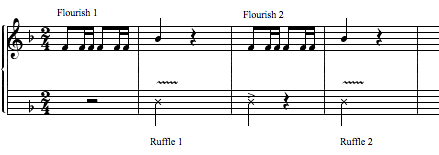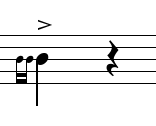Answer: Understanding that jazz and pop are not really my realm, I think I can help here. The word "ruffle" refers to a drum roll and accented finish note that is combined with a "flourish" in the brass to introduce marches, national anthems, and other honors music. From this we get the shortened term "ruff," which means several quick grace notes on a drum preceding the accented note - a ruff can be from one to four strokes played as quickly as a roll. But beyond four strokes it is really just a roll.
I figure you're referring to jazz ruffs, but if you're interested you can hear good examples of ruffles and flourishes as played by the United States Army Band:
http://www.usarmyband.com/Audio/ceremonial_music_guide.html
Here's a notated version of a typical pair of Ruffles and Flourishes . "Hail to the Chief" is preceded by four Ruffles and Flourishes.

The wiggly tremolo sign above is meant as a drum roll.
A two-stroke "ruff" could look like this (I'll use regular note heads so it's easier to see)

Follow-up question! So, if I got it right, ruff is a - let's call it a longer version of a drag? If I'm correct, a drag has two gracenotes before accented finish note and a ruff has 3? Or not?
Follow-up answer: I hope I don't have to make stuff up here - as I understand it, a ruff can be anywhere from a single grace note to four (all these being before the beat, you understand, with the following accent note on the beat). There appears to be some overlap in terminology, however.
The nomenclature of drum "rudiments" has been organized by the "National Association of Rudimental Drummers." (Who knew?). The "Percussive Arts Society" added another 14, to make a total of 40 possible drum "rudiments."
This could get humorous really fast. While some sources have described the "ruff" as anywhere from 1 to 4 unaccented quick grace notes, you've also got the "drag," which is the same thing as a two-stroke "ruff," as near as I can tell. This is to be distinguished from the "diddle," which is two notes played quickly by one hand but whose tempo is that of the prevailing context, whereas the ruff is always just very quick. And then there's the "paradiddle," which is comprised of two successive diddles, and the "dragadiddle," and even the "drag paradiddle."
If you want a really complete list of these, check the chart at Wikipedia, which is here:
That should keep you diddling for hours.

